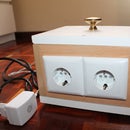Introduction: IoT PiRadio/Alarm Using Cayenne.
Hi again!
This time I'm here to present you a very simple project, however a very funny one.
Two years ago when I have bought my first raspberry pi, I had done an Internet PiRadio where I could listen to some foreign radios.
Today I had done a little more! I had removed my LCD showing what radio station I was listening, and the navigation buttons, and added an IoT dashboard named Cayenne.
With Cayenne I'm able to toggle the radio On and Off, increase and decrease volume, and cycle trough my radio playlist.
With this configuration you can also add triggers to it, for example to wake you up at a certain time. (However I don't recommend that you use it for work or school since I haven't tested it deeply),
The following steps will describe how you should proceed to implement one like me.
The requirements that you will need to build this project are:
- Raspberry Pi
- Internet Connection
- A Python Script
- Resistors
- Wires
- Audio Output (Speakers, Headphones...)
- Breadboard
Step 1: Have a Fresh Raspbian Image Running on Your Pi With SSH and VNC Enabled.
This is the first thing that you need to have before continue further.
You will need to install Raspbian on your Raspberry Pi.
Don't forget to:
sudo apt-get update sudo apt-get dist-upgrade
I also recommend that you enable SSH and VNC, since the goal is to have an headless Pi.
Step 2: Install MPC and MPD, and Add Radio Stations to Your Playlist.
Install MPD (Music Player Daemon)and MPC (Client):
sudo apt-get install mpc mpd
Add some radio station to your playlist:
mpc add http://bbcmedia.ic.llnwd.net/stream/bbcmedia_radio1_mf_p
Play it.
mpc play 1
If you don't listen anything check if you have your audio output connected.
Remember that the "mpc add" command is the one that lets you add radios/musics to your playlist.
To clear your playlist just type "mpc clear" and add them again.
You can also tweek mpd but since I don't have much experience I recommend that you google it.
Step 3: Install Cayenne on Your Raspberry Pi
I will not describe here the procedure of installing Cayenne on your Raspberry, since the Cayenne team has already done a great job describing it.
You can check everything you need at https://cayenne.mydevices.com
Step 4: Wire the Resistors Between GPIO Pins.
As you can see, this project only use 10K resistors to connect some of your Raspberry GPIO pins.
The purpose of this setup is to set 4 pins of your Raspberry as Inputs and 4 as Outputs, that will be used by Cayenne and a Python Script.
The mapping of outputs and inputs are:
OUT IN
18 ----->> 21
23 ----->> 16
24 ----->> 20
25 ----->> 26
Step 5: Python Script
This project uses a python script, that will check the status of your input pins.
There are 4 inputs that will do the following functions:
- Cycle through your radio stations
- On/Off button
- Volume +
- Volume -
The script is very simple. It uses an infinite While loop, and some If statements that will listen to when a change of your input state occurs.
Create a file with the name that you want with the code bellow:
#!/usr/bin/env python
#Some code was used from www.suppertime.co.uk/blogmywiki
import RPi.GPIO as GPIO
import time
import os
GPIO.setmode(GPIO.BCM)
GPIO.setup(16, GPIO.IN)
GPIO.setup(20, GPIO.IN)
GPIO.setup(21, GPIO.IN)
GPIO.setup(26, GPIO.IN)
# sets initial station number to channel 1
station = 1
while True:
#initialize the previous input of on/off to 0
prev_input_on_off= 0
#Take a readling from pin 26
input_on_off = GPIO.input(26)
#If the last reading from On/Off Button was low and now is high:
if ((not prev_input_on_off) and input_on_off):
os.system("mpc play " + str(station))
#initialise previous input variables to 0
prev_input_cycle = 0
prev_input_plus = 0
prev_input_minus= 0
while True:
#take a reading from pins 16 21 20 26
input_cycle = GPIO.input(21)
input_plus = GPIO.input(16)
input_minus = GPIO.input(20)
#If the last reading was low and this one high, do stuff
if ((not prev_input_cycle) and input_cycle):
# assumes you have 4 radio stations configured
station += 1
if station > 4:
station = 1
os.system("mpc play " + str(station))
if ((not prev_input_plus) and input_plus):
# Volume +5
os.system("mpc volume +5")
if ((not prev_input_minus) and input_minus):
# Volume -5
os.system("mpc volume -5")
#update previous inputs
prev_input_cycle = input_cycle
prev_input_minus = input_minus
prev_input_plus = input_plus
prev_input_on_off = input_on_off
#Check if the On/Off Button is still On.
time.sleep(0.05)
input_on_off = GPIO.input(26):
if (input_on_off == 0)
break
else:
os.system("mpc stop")
time.sleep(2) Step 6: Setup Your Cayenne Dashboard
Now it is time to setup your Cayenne.
Here you will need to do 3 major steps.
- Set Outputs
- Set Inputs
- Set Triggers
All the inputs and outputs are the Generic Type.
If you have any questions or doubts regarding how to set them, please read the Cayenne Docs.
Check the Wire the Resistors between GPIO pins step and the picture to see which button does what.
1.
Create the following Outputs:
Cycle Button
Volume +
Volume -
Start / Stop
2.
And the Inputs:
Cycle Button State
Volume + State
Volume - State
Start / Stop
3.
After you will need to use triggers in order to "fool" cayenne. The purpose is to set an Output to low every time you click to set it to High.
I need to used this for Cycle and Volumes since cayenne doesn't have yet the option to set a like a Pulse Button.
Remeber that you can also add Events for example to turn the radio On or Off at a certain time, or any other action that you need.
Step 7: Listen to RadiOoooo!
So now that everything is done in order to listen to your radio, you just need to run your Python script and press your Start Button on Cayenne.
Here is a short video showing this version of PiRadio working!
Please let me know if you have any questions so I can help you doing this simple but very nice project =)

Participated in the
IoT Builders Contest

Participated in the
Amps and Speakers Contest 2016










